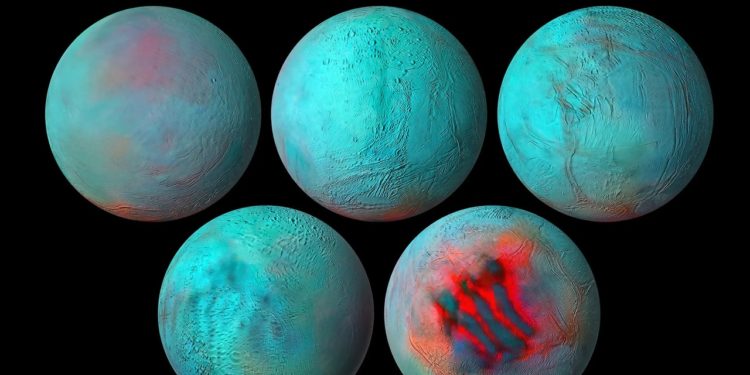By WIRED
And yet, defiantly, these alien seas remain liquid.
A Mirror-Wrapped Ocean
Scientists suspect that a handful of moons orbiting Jupiter and Saturn—and maybe even some spinning around Uranus and Neptune—harbor oceans. Hefty Ganymede and crater-scarred Callisto produce weak, Europa-like magnetic signals. Saturn’s haze-covered Titan, too, very probably has a liquid-water subsurface ocean. These “are the five that most scientists in the community feel pretty confidently about,” said Mike Sori, a planetary scientist at Purdue University.
So far, the only absolute oceanic certainty is Enceladus. “That’s a no-brainer,” said Carly Howett, a planetary scientist at the University of Oxford.
In the 1980s, some scientists suspected Enceladus had plumes; Saturn’s E ring was so clean and shiny that something—perhaps from one of its moons—must be leaking into space and constantly refreshing it. After Cassini finally witnessed that planet-garnishing magic in action, scientists briefly questioned whether the moon’s south-polar plumes might be the work of sunlight vaporizing ice in the moon’s shell—a bit like dry ice boiling away when heated, perhaps by sunlight.
“For a while, there was this argument about whether there needed to be an ocean at all,” Nimmo said. “What really nailed that was when [Cassini] flew through the plume and they found salt—sodium chloride. That’s an ocean.” There was still a chance that these plumes could be erupting from a smaller, more isolated sea. But further Cassini observations revealed that Enceladus’ shell is rocking back and forth so acutely that it must be separated from the moon’s deeper interior by a global ocean.
The plumes also pump out hydrogen and quartz, signs of deep-sea hydrothermal vent activity, said Frank Postberg, a planetary scientist at the Free University of Berlin. On Earth, such vents produce the heat and chemistry needed to power ecosystems that exist beyond the reach of sunlight—communities of organisms that scientists once thought could not exist in our photosynthetically dependent world.
But what could be powering a vent system strong enough to heat an entire ocean? Another moon—this one of the fiery variety—would provide those clues.
The Eternal, Infernal Tides
In June 1979, a month before Voyager 2’s close flyby of Europa, scientists announced that Voyager 1 had glimpsed titanic, umbrella-shaped plumes billowing into space above Io—the eruptive fingerprints of several volcanoes.
This observation should have been baffling: Volcanism requires an internal heat source, and Io, like the other icy moons, should have been nothing more than embers. But a few months earlier, an independent team of scientists had correctly predicted that Io might be a hyperactive volcanic world.







Discussion about this post